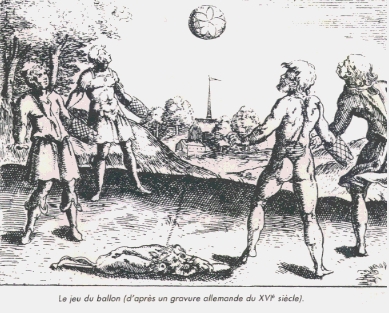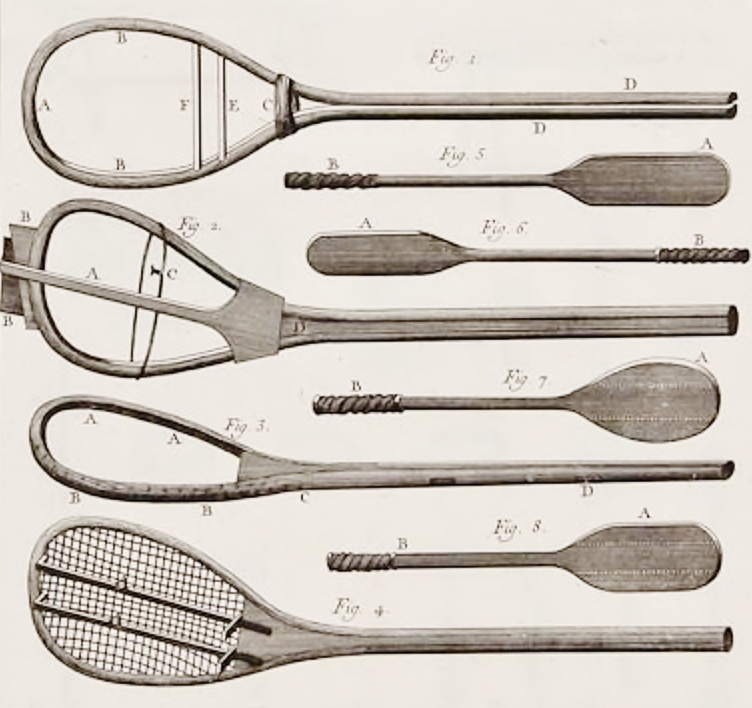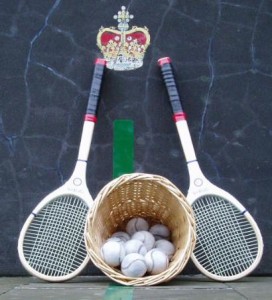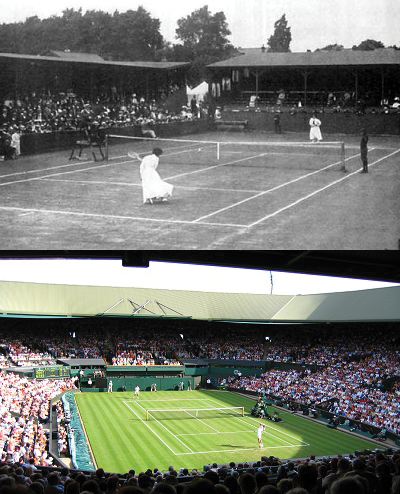The Complete History of Tennis
Ever wondered about the origins of tennis and how it came about? We were curious too, so we did a little sleuthing around on the history of tennis to see what we could find. Turns out, the game we know and love today started off as a completely different kind of tennis, taking centuries upon centuries to evolve into the modern day sport. Yes, that’s right, tennis has been traced back a millennium ago, possibly even a couple more according to some theorists. So, what are you waiting for? Let’s take a walk back through the complete history of tennis!
The Complete History of Tennis
Predecessors of Tennis
 The history of tennis has had some debate behind its true origins. Now, it wasn’t exactly in the cave man days when this happened, but many people believe a primitive version of tennis was first played in either Egypt, Greece, or Rome, although no clear evidence is available. The only clues are some subtle hints strewn about these civilizations’ cultures. For instance, the word tennis is believed to derive from the Egyptian town of Tinnis, while the word racquet could have come from the Arabic word, rahat, which means the palm of the hand. Ancient carvings have also been found in Egypt depicting a type of game in which a ball was hit over a net, dating as far back as 1500 BC.
The history of tennis has had some debate behind its true origins. Now, it wasn’t exactly in the cave man days when this happened, but many people believe a primitive version of tennis was first played in either Egypt, Greece, or Rome, although no clear evidence is available. The only clues are some subtle hints strewn about these civilizations’ cultures. For instance, the word tennis is believed to derive from the Egyptian town of Tinnis, while the word racquet could have come from the Arabic word, rahat, which means the palm of the hand. Ancient carvings have also been found in Egypt depicting a type of game in which a ball was hit over a net, dating as far back as 1500 BC.
It wasn’t until the 11th or 12th century (around year 1000), however, that the first recorded history of tennis was found in the form of an early version of the sport. In France, French monks created a courtyard ball game called Jeu de Paume, meaning, “game of the hand“. There are also theories that the word tennis came from the French word tenez, which means something along the lines of “take heed“, “to take“, “hold“, or “receive“. Players would do a ritual where they would shout out “tenez” before serving to their opponent. The game was played against the walls or over a rope that they would put up, which was often played during religious ceremonies. Jeu de Paume’s rules and scoring are similar to that of modern day tennis, although a bit more complicated.
The game became very popular and spread throughout Europe. The game was referred to as Jeu de Paume only until racquets had become widespread. Courtyard playing areas began to be made into indoor courts where the ball would still be hit off the walls. After a while, they realized that using leather gloves was much easier to hit the ball with than just a bare hand, and eventually, a wooden paddle was created in order to hit and serve the ball more effectively. Thus, everyone marveled at the birth of the first racquet.

Early versions of Jeu de Paume racquets.
The Beginnings of Real Tennis
 By this time, around the 13th century, there were reported to be as many as 1800 courts in France. The game became so popular that even the Pope and Louis IV tried to ban it in France, although met with failure. The game even spread to England, where the nobility like Henry VII (1413-22) and Henry VIII (1509-47) played avidly. The design of the racquet improved over time and by the year 1500, the racquet was standard equipment, made from a combination of strings made out of sheep gut bound in a wooden frame, with a shape similar to a squash racquet. It was also no longer played against a wall, but across a net just as you’d imagine. This is when the game started to be referred to as “tennis” in English and much later “real tennis” to refer to the antiquated sport that differs from modern day tennis.
By this time, around the 13th century, there were reported to be as many as 1800 courts in France. The game became so popular that even the Pope and Louis IV tried to ban it in France, although met with failure. The game even spread to England, where the nobility like Henry VII (1413-22) and Henry VIII (1509-47) played avidly. The design of the racquet improved over time and by the year 1500, the racquet was standard equipment, made from a combination of strings made out of sheep gut bound in a wooden frame, with a shape similar to a squash racquet. It was also no longer played against a wall, but across a net just as you’d imagine. This is when the game started to be referred to as “tennis” in English and much later “real tennis” to refer to the antiquated sport that differs from modern day tennis.
The history of tennis continues when in 1599, the rules of real tennis officially became codified and the game had become extremely popular in Europe. 17th-century nobility from France, Spain, Italy, the Netherlands, and the Habsburg Empire routinely took part in playing. However, the game suffered in the English empire due to Puritanism, which associated the game with gambling. Unfortunately, during the Age of Napoleon (around the 1700s), many of the royal families of Europe were besieged, leading to the game of real tennis being practically deserted. Other racquet sports were invented in England at this time, such as rackets and squash.
Although there was a short revival of real tennis in Victorian England, by this time the game of “lawn tennis” had already been introduced, which more people preferred due to its lower difficulty (and the fact that females could also play, whereas real tennis was largely a male dominated sport).
The Introduction of Lawn Tennis
An important although easily neglected moment in the history of tennis occurs in 1850 with the vulcanization process for rubber being introduced by Charles Goodyear (yes, the guy Goodyear Tires is named after). With vulcanization, people started experimenting with bouncier rubber balls on grass. Then, well, you can kind of guess the rest.
In 1873, a Welsh inventor and British army officer by the name of Walter Clopton Wingfield designed and patented a game–called Sphairistikè (Greek, meaning “skill in playing at ball”)–which took many elements from real tennis and closely resembles the modern day game of tennis. It included racquets, rubber balls, and a court made out of grass that was in the shape of an hourglass. The court was actually smaller than a modern tennis court and the net was taller. Although Sphairistikè was the name that Wingfield called it, many people started referring it to “lawn tennis”, since it was played on a grass court. Due to criticism and the failure to keep up with his patent, Wingfield left the development of the game for others to create.
 In 1874, Mary Ewing Outerbridge–having played a game of lawn tennis in Bermuda–introduced the game to the United States by setting up a court in State Island Cricket and Baseball Club in New York. The court was still in the shape of an hourglass, but America quickly fell in love with the sport.
In 1874, Mary Ewing Outerbridge–having played a game of lawn tennis in Bermuda–introduced the game to the United States by setting up a court in State Island Cricket and Baseball Club in New York. The court was still in the shape of an hourglass, but America quickly fell in love with the sport.
In 1877, the first Wimbledon tennis tournament was held at the All England Club Croquet, which replaced Wingfield’s original model of an hourglass court with the modern day rectangular court. The rules of the game were essentially the same as the rules of today’s modern tennis, and the tournament became so popular that the club changed its name to the All England Croquet and Lawn Tennis Club. Since 1877, the history of tennis has not changed much, with the only exception being the adoption of the tie-break rule in 1971.
